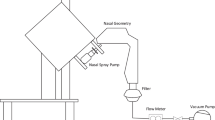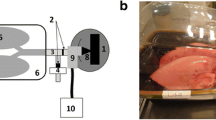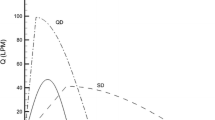Abstract
Knowing aerosol deposition distribution (ADD) in the respiratory tract is crucial in assessing dose–response relationship and optimizing inhalation therapy. However, characterization of ADD inside the airway is challenging, due to its inaccessibility to standard measurement instruments. Radioactive imaging techniques such as gamma scintigraphy, SPECT, and PET are capable of characterizing ADD and have proven valuable in drug-device designs, but these techniques are costly, complex-to-use, and pose radiation risks to patients. The objective of this study is to develop and validate a simple and practical technique to visualize nebulized aerosol deposition in a human airway model. An anatomically accurate mouth–lung airway model was used in both experiments and numerical simulations for validation purpose. A sectional hollow cast replica was developed and fabricated using 3D printing. Sar-Gel was utilized to visualize the aerosol deposition distribution on the inner walls of the upper respiratory airway. Computational simulations were conducted to understand the underlying mechanisms of particle transport and deposition. The deposition distribution obtained from the Sar-Gel experiments and numerical simulations resembled each other to a high degree. Specifically, the deposition hot spots in the upper trachea were nearly identical between experiment and simulation, suggesting that the computational model is adequate in capturing the mechanisms of particle transport and deposition. Considering the inhalation effect, more drug particles were delivered to the lungs at 10 L/min than at 30 L/min. The Sar-Gel based method in combination with sectional upper airway casts appears to be a practical approach to visualize regional depositions with nebulizers. Computational modeling and Sar-Gel tests can be used as complementary in optimizing inhalation therapies.
Graphical Abstract








Similar content being viewed by others
References
Alderson PO, Boonvisut S, McKnight RC, Hartman AF (1976) Pulmonary perfusion abnormalities and ventilation-perfusion imbalance in children after total repair of tetralogy of Fallot. Circulation 53:332–337
Berg EJ, Weisman JL, Oldham MJ, Robinson RJ (2010) Flow field analysis in a compliant acinus replica model using particle image velocimetry (PIV). J Biomech 43:1039–1047
Byron PR, Hindle M, Lange CF, Longest PW, McRobbie D, Oldham MJ, Olsson B, Thiel CG, Wachtel H, Finlay WH (2010) In vivo-in vitro correlations: predicting pulmonary drug deposition from pharmaceutical aerosols. J Aerosol Med Pulm Drug Deliv 23:59–69
Cohen B, Briant J (1989) Flow distribution in human and canine tracheobronchial airway casts. Health Phys 57:21–27
Cohen BS, Sussman RG, Lippmann M (1990) Ultrafine particle deposition in a human tracheobronchial cast. Aerosol Sci Technol 12:1082–1093
Cohen BS, Sussman RG, Lippmann M (1993) Factors affecting distribution of airflow in a human tracheobronchial cast. Respir Physiol 93:261–278
Corley RA, Kabilan S, Kuprat AP, Carson JP, Minard KR, Jacob RE, Timchalk C, Glenny R, Pipavath S, Cox T, Wallis CD, Larson RF, Fanucchi MV, Postlethwait EM, Einstein DR (2012) Comparative computational modeling of airflows and vapor dosimetry in the respiratory tracts of rat, monkey, and human. Toxicol Sci 128:500–516
Courrier HM, Butz N, Vandamme TF (2002) Pulmonary drug delivery systems: recent developments and prospects. Crit Rev Ther Drug Carr Syst 19:425–498
Darquenne C, Fleming JS, Katz I, Martin AR, Schroeter J, Usmani OS, Venegas J, Schmid O (2016) Bridging the gap between science and clinical efficacy: physiology, imaging, and modeling of aerosols in the lung. J Aerosol Med Pulm Drug Deliv 29:107–126
De Backer JW, Vos WG, Vinchurkar SC, Claes R, Drollmann A, Wulfrank D, Parizel PM, Germonpre P, De Backer W (2010) Validation of computational fluid dynamics in CT-based airway models with SPECT/CT. Radiology 257:854–862
Dhand R (2002) Nebulizers that use a vibrating mesh or plate with multiple apertures to generate aerosol. Respir Care 47:1406–1416
Dolovich MB (2001) Measuring total and regional lung deposition using inhaled radiotracers. J Aerosol Med 14:S35–S44
Dolovich MB, Bailey DL (2012) Positron emission tomography (PET) for assessing aerosol deposition of orally inhaled drug products. J Aerosol Med Pulm Drug Deliv 25:S52–S71
Dong J, Shang Y, Inthavong K, Tu J, Chen R, Bai R, Wang D, Chen C (2016) Comparative Numerical modeling of inhaled nanoparticle deposition in human and rat nasal cavities. Toxicol Sci 152:284–296
Fleming J, Conway J, Majoral C, Katz I, Caillibotte G, Pichelin M, Montesantos S, Bennett M (2015) Controlled, parametric, individualized, 2-D and 3-D imaging measurements of aerosol deposition in the respiratory tract of asthmatic human subjects for model validation. J Aerosol Med Pulm Drug Deliv 28:432–451
Frerichs I, Dargaville PA, van Genderingen H, Morel DR, Rimensberger PC (2006) Lung volume recruitment after surfactant administration modifies spatial distribution of ventilation. Am J Respir Crit Care Med 174:772–779
Guo Y, Laube B, Dalby R (2005) The effect of formulation variables and breathing patterns on the site of nasal deposition in an anatomically correct model. Pharm Res 22:1871–1878
Han B, Hirahara H (2016) Effect of gas oscillation-induced irreversible flow in transitional bronchioles of human lung. J Flow Control Meas Vis 4:171–193
Han B, Hirahara H, Yoshizaki S (2016) Streaming caused by oscillatory flow in peripheral airways of human lung. Open J Fluid Dyn 6:242–261
Hirahara H, Iwazaki K, Ahmmed MU, Nakamura M (2011) Numerical analysis of air flow in dichotomous respiratory channel with asymmetric compliance under HFOV condition. J Fluid Sci Technol 6:932–948
Inthavong K, Tian ZF, Li HF, Tu JY, Yang W, Xue CL, Li CG (2006) A numerical study of spray particle deposition in a human nasal cavity. Aerosol Sci Technol 40:1034
Inthavong K, Tao Y, Petersen P, Mohanarangam K, Yang W, Tu J (2016) A smoke visualisation technique for wake flow from a moving human manikin. J Vis 19:1–13
Jones RL, Nzekwu MMU (2006) The effects of body mass index on lung volumes. Chest 130:827–833
Kim J-K, Kawahashi M, Hirahara H, Iwasaki Y (2009) Experimental analysis of oscillatory airflow in a bronchiole model with stenosis. J Vis 12:109–118
Kim J, Xi J, Si XA (2013) Dynamic growth and deposition of hygroscopic aerosols in the nasal airway of a 5-year-old child. Int J Numer Meth Biomed Eng 29:17–39
Kim J, Xi J, Si X, Berlinski A, Su WC (2014) Hood nebulization: effects of head direction and breathing mode on particle inhalability and deposition in a 7-month-old infant model. J Aerosol Med Pulm Drug Deliv 27:209–218
Kundoor V, Dalby RN (2010) Assessment of nasal spray deposition pattern in a silicone human nose model using a color-based method. Pharm Res 27:30–36
Kundoor V, Dalby RN (2011) Effect of formulation- and administration-related variables on deposition pattern of nasal spray pumps evaluated using a nasal cast. Pharm Res 28:1895–1904
Labiris NR, Dolovich MB (2003a) Pulmonary drug delivery. Part I: physiological factors affecting therapeutic effectiveness of aerosolized medications. Br J Clin Pharmacol 56:588–599
Labiris NR, Dolovich MB (2003b) Pulmonary drug delivery. Part II: the role of inhalant delivery devices and drug formulations in therapeutic effectiveness of aerosolized medications. Br J Clin Pharmacol 56:600–612
Latifi K, Feygelman V, Moros EG, Dilling TJ, Stevens CW, Zhang GG (2013) Normalization of ventilation data from 4D-CT to facilitate comparison between datasets acquired at different times. PLoS ONE 8:e84083
Li Z, Kleinstreuer C, Zhang Z (2007) Simulation of airflow fields and microparticle deposition in realistic human lung airway models. Part II: particle transport and deposition. Eur J Mech B 26:650–668
Longest PW, Xi J (2007a) Computational investigation of particle inertia effects on submicron aerosol deposition in the respiratory tract. J Aerosol Sci 38:111–130
Longest PW, Xi J (2007b) Effectiveness of direct Lagrangian tracking models for simulating nanoparticle deposition in the upper airways. Aerosol Sci Technol 41:380–397
Longest PW, Xi JX (2008) Condensational growth may contribute to the enhanced deposition of cigarette smoke particles in the upper respiratory tract. Aerosol Sci Technol 42:579–602
Ma B, Lutchen KR (2006) An anatomically based hybrid computational model of the human lung and its application to low frequency oscillatory mechanics. Ann Biomed Eng 34:1691–1704
Newman S, Bennett WD, Biddiscombe M, Devadason SG, Dolovich MB, Fleming J, Haeussermann S, Kietzig C, Kuehl PJ, Laube BL, Sommerer K, Taylor G, Usmani OS, Zeman KL (2012) Standardization of techniques for using planar (2D) imaging for aerosol deposition assessment of orally inhaled products. J Aerosol Med Pulm Drug Deliv 25(Suppl 1):S10–S28
Sakai H, Watanabe Y, Sera T, Yokota H, Tanaka G (2015) Visualization of particle deposition in human nasal cavities. J Vis 18:349–357
Si X, Xi J, Kim J (2013) Effect of laryngopharyngeal anatomy on expiratory airflow and submicrometer particle deposition in human extrathoracic airways. Open J Fluid D 3:286–301
Sznitman J, Sutter R, Altorfer D, Stampanoni M, Rosgen T, Schittny JC (2010) Visualization of respiratory flows from 3D reconstructed alveolar airspaces using X-ray tomographic microscopy. J Vis 13:337–345
Thompson RB, Finlay WH (2012) Using MRI to measure aerosol deposition. J Aerosol Med Pulm Drug Deliv 25:55–62
Waldrep JC, Dhand R (2008) Advanced nebulizer designs employing vibrating mesh/aperture plate technologies for aerosol generation. Curr Drug Deliv 5:114–119
Xi J, Longest PW (2007) Transport and deposition of micro-aerosols in realistic and simplified models of the oral airway. Ann Biomed Eng 35:560–581
Xi J, Longest PW (2008) Numerical predictions of submicrometer aerosol deposition in the nasal cavity using a novel drift flux approach. Int J Heat Mass Transfer 51:5562–5577
Xi J, Longest PW, Martonen TB (2008) Effects of the laryngeal jet on nano- and microparticle transport and deposition in an approximate model of the upper tracheobronchial airways. J Appl Physiol 104:1761–1777
Xi J, Kim J, Si XA, Zhou Y (2013) Diagnosing obstructive respiratory diseases using exhaled aerosol fingerprints: a feasibility study. J Aerosol Sci 64:24–36
Xi J, Si X, Gaide R (2014a) Electrophoretic particle guidance significantly enhances olfactory drug delivery: a feasibility study. PLoS ONE 9:e86593
Xi J, Si X, Kim J, Su G, Dong H (2014b) Modeling the pharyngeal anatomical effects on breathing resistance and aerodynamically generated sound. Med Biol Eng Comput 52:567–577
Xi J, Kim J, Si XA, Corley RA, Zhou Y (2016a) Modeling of inertial depositions in scaled models of rat and human nasal airways: towards in vitro regional dosimetry in small animals. J Aerosol Sci 99:78–93
Xi J, Si XA, Kim J, Zhang Y, Jacob RE, Kabilan S, Corley RA (2016b) Anatomical details of the rabbit nasal passages and their implications in breathing, air conditioning, and olfaction. Anat Rec 299:853–868
Xi J, Yuan JE, Si XA (2016c) Simulation study of electric-guided delivery of 0.4 µm monodisperse and polydisperse aerosols to the ostiomeatal complex. Comput Biol Med 72:1–12
Xi J, Yuan JE, Zhang Y, Nevorski D, Wang Z, Zhou Y (2016d) Visualization and quantification of nasal and olfactory deposition in a sectional adult nasal airway cast. Pharm Res 33:1527–1541
Zhang Z, Kleinstreuer C (2002) Transient airflow structures and particle transport in a sequentially branching lung airway model. Phys Fluids 14:862–880
Zhang Z, Martonen TB (1997) Deposition of ultrafine aerosols in human tracheobronchial airways. Inhal Toxicol 9:99–110
Zhang Z, Kleinstreuer C, Kim CS (2006) Water vapor transport and its effects on the deposition of hygroscopic droplets in a human upper airway model. Aerosol Sci Technol 40:52–67
Funding
This study was funded by Central Michigan University Innovative Research Grant P18601 and Early Career Award P622911. Tyler Demski was gratefully acknowledged for reviewing the manuscript.
Author information
Authors and Affiliations
Corresponding author
Ethics declarations
Conflict of interest
The authors report no conflicts of interest in this work.
Rights and permissions
About this article
Cite this article
Xi, J., Yang, T., Talaat, K. et al. Visualization of local deposition of nebulized aerosols in a human upper respiratory tract model. J Vis 21, 225–237 (2018). https://doi.org/10.1007/s12650-017-0456-0
Received:
Revised:
Accepted:
Published:
Issue Date:
DOI: https://doi.org/10.1007/s12650-017-0456-0




